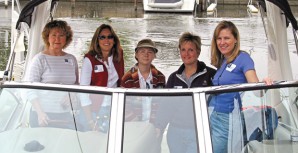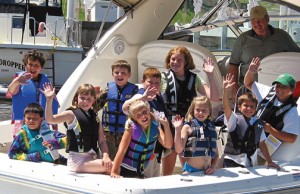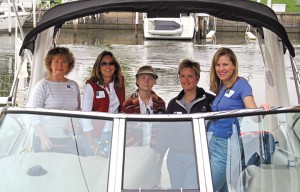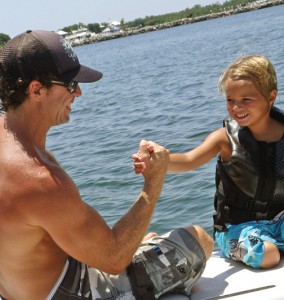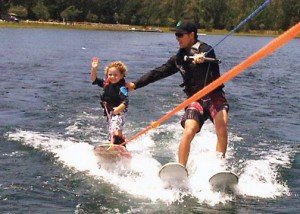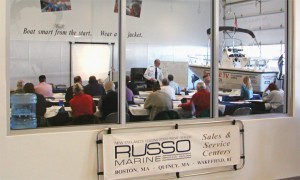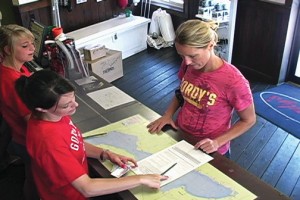Boating safety: A dealer’s responsibility
B&E Women-620x320 Brent Renneke, Managing Editor
March 1, 2013
Dealerships who devote resources to boating safety training are able to make an impact on their own waters and lift the industry as a whole.
In 2011, United States boating fatalities increased 12 percent over the prior year, despite boater registration contracting by 2 percent, according to the U.S. Coast Guard. There is no common theme among the 758 deaths totaled in 2011, except for the assumption many were preventable.
Increasing boating safety is a duty many dealers have taken upon themselves by offering extensive orientations after a boat purchase and numerous training options for its customers. For most, these offerings are not only deemed necessary to be considered a full-service dealership, but also their duty to the boating public.
“We as dealers need to make it so customers feel safe and confident on the water. If we can do that, we are helping the whole industry,” said Rod Bensz, owner of B&E Marine in Michigan City, Ind.
B&E Marine offers classes specifically for either women or kids.
Boaters who return home from a safe, enjoyable day on the water do not make the news. Often, boating-related headlines are centered on accidents, many of which are fatal. Those in the industry understand such attention is not helpful to growing participation, and many dealers make the extra effort to decrease these tragedies.
And that effort begins with the delivery of a new or used boat, at which point dealers perform orientations that leave the customer fully comfortable operating the boat.
Medford, Mass.-based Russo Marine goes over each boat purchase with the customer using two employees – one at the helm with the customer and another familiar with the boat’s systems, who is often a service employee. The double-team approach leaves the new owner with a calming person providing operation instructions, while the other can open the hatch and answer any technical questions about the boat.
“Whether he is spending $10,000 or a million dollars, he may be new to boating or at least new to that boat,” president Larry Russo said. “We want to put a person at the helm that will diffuse any of those anxieties.”
The best delivery orientations put no time limit to achieve that goal, whether it is two hours or even two days.
In the past, boat orientations were done only with the person largely responsible for driving the boat, who was predominantly male. Today, dealerships like B&E Marine encourage also training the spouse to operate the boat.
Bensz said this is a necessary safety precaution in case the primary operator is ever left incapable to drive due to a health issue, for example. And in his experience, Bensz said a neutral third party, like his delivery staff, is more effective in training the inexperienced spouse.
“[To have that training] gives everyone a better feeling when they are out on the water,” he said. “It is not that hard to put this boat in a dock; there are just a few simple steps.”
A solid, fun delivery experience not only makes for safer boaters, but it is also a vital customer satisfaction tool. At Pride Marine in Bracebridge, Ontario, the only responsibility for a group of employees is to guarantee a rewarding delivery process. The delivery staff also gives the customer their cell phone number, which the new boat owner can call 24/7 with any questions.
The resources devoted to the process paid off, as president Paul Nickel said approximately 70 percent of all CSI scores favorably mention his delivery personnel by their first name.
At Miami Nautique International, water sports training reduces towing accidents.
For dealerships like Miami Nautique International that specialize in water sports, the delivery is the time when you can ensure safe towing, Kim Laursen, vice president and co-owner of the dealership, said.
Laursen said each delivery is made with a certified water sports coach, who is able to ensure a fail-safe experience behind the boat. Another staff member provides on-the-water driver safety training to multiple family members. This training is comprehensive, including education on manatee zones, ballast choices and how to attack the next trick.
“An afternoon on the water can easily be spoiled by running over a rope, or worse yet, an injury,” said Laursen. “Providing our customers with adequate safety training on day one helps to ensure a fail-safe summer of fun.”
Such devotion may be easier with a customer who spent thousands of dollars at your dealership, but for those with rental operations, a similar, thorough process still needs to be followed.
Gordy’s Lakefront Marine has been renting boats since its inception in 1955. Today, it works with customers on a safety checklist designed to provide the tools needed for careful operation.
Steele Whowell, owner/operator of the Fontana, Wis.-based dealership, said the checklist goes over where to go on the lake, weather conditions, how to sit on the boat, swimming around it, how to pull a skier and much more. This checklist is reviewed and updated on an annual basis with Gordy’s local Department of Natural Resources.
The customer is also given a thorough walkthrough of the boat, including operating it. Whowell said the staff giving the walkthrough gauges the customer’s familiarity of the boat and the necessary time needed for additional training.
“This department is where we get the largest amount of new boaters, so it is where we need to spend the most time going through the boat with them,” he said.
Also, Gordy’s does not allow the operator of the boat to consume any alcohol, and if a customer shows up with signs of alcohol use, he or she is no longer renting a boat.
Resources for safety
As boating fatalities have increased in recent years, boat owners have increased their attentiveness to boating safety.
The United States Power Squadron is a non-profit provider of classes dedicated to making boating safer. Bill Jenkins, who is the executive director for the national organization’s Michigan City, Ind., chapter, said interest in his classes has greatly increased over the past few years. This trend is vital for the boating industry, according to Jenkins.
“Unlike a vehicle, a boat doesn’t require licensing. You just need cash or financing capability,” Jenkins said. “We have had people buy large boats, and they don’t know how to get it stopped. That is very scary.”
In order to further push people into these classes, it is up to the dealers, many of whom partner with third-party organizations like the Power Squadron.
Russo Marine’s 50-person classroom is a vital training tool for the dealership.
Russo Marine has had a relationship with Boatwise, which is another boat training provider, since 1995. Russo said he even built a 50-person classroom that he rents to Boatwise for its classes. Russo Marine pays the classroom fees for its customers, but both non-Russo and Russo customers attend classes in the room – a major benefit for the company, according to Russo.
“Non-Russo Marine customers are paying to walk through my showroom,” he said.
The main goal of Russo subsidizing the classes for his customers, however, is that smarter boaters are happier boaters. By going to a third party for training, Russo said he knows the curriculums are up to date, and his customers receive insurance discounts as added incentive.
Jenkins and the Power Squadron work with B&E Marine’s Bensz, who provides contact information for the Power Squadron to customers, which they can use to find out about classes hosted at B&E Marine. Jenkins said dealers like Bensz have been pivotal in increasing attendance at its classes, including more females attending with their spouses.
This trend of increased female participation is welcomed by the marine industry, which has worked tirelessly to get women more involved in boating with many dealers offering Women on the Water courses.
Besides the previously stated need for more than one capable boat operator on board, the participation objective is to make boating a family-wide activity, not something driven by dad’s availability to drive the boat.
“If we can get both of them on board, they stay in boating longer, and that is good for boating as a whole,” Bensz said. “If the wife is not coming down with the kids, that’s not good for anybody.”
At Pride Marine, a female instructor teaches its boating classes for women. Also, anywhere from two to four boats representing different segments are used in the classes so attendees are comfortable with boating as a whole, not just a particular model, according to Nickel.
Gordy’s staff spends considerable time with its renters to ensure they are prepared.
Gordy’s also puts in extra effort with families by often following up with the spouse after the delivery is complete. Whowell said an instructor often meets the spouse who is not the primary boater for private lessons on his or her boat.
“People’s reservation with boating is they fear the unknown,” Whowell said. “We spend some time with them to show them how easy it can be, it can be safe and you can do it with your kids.”
Pride Marine will often travel out to its customers’ homes, according to Nickel, who said often his customers are intimidated by the marina setting. Like with Gordy’s, the effort is not a revenue stream for the dealership, but rather to get more people on the water. Such individual lessons have increased by 300 percent since their first year.
A similar orientation to boating is something dealers like Pride are trying to perform at a much younger age.
Nickel said his dealership partnered with a number of children’s camps in the area by providing the camp with boats. Of the 1,500 children attending these camps, he estimates half get on a Pride boat for boating safety training. The result, according to Nickel, is many of the campers are better boaters than their untrained parents.
“It is a cost of doing business, but it is giving back to the industry – almost like my mini-Discover Boating,” he said.
B&E Marine organizes classes specifically for the youth. After attending the classes, they have a higher comfort level with boating, according to Bensz, who said the children appreciate knowing they can help their parents out and know what they can and cannot do on a boat.
The classes are catered to children by reducing classroom hours in favor of getting out on the water and driving the boat. The result is the local Department of Natural Resources certifies them.
The safety mindset
A Google news search for “boat” returns more horror stories about drunk boating, collisions and careless operation than one can count. Although these stories will never completely go away, industry-wide promotion of safety – from the youth to the owner to the hesitant spouse – is extremely important.
“The media scares people from boating, but we have seen a huge improvement,” said Jenkins of Power Squadron. “We are really proud of that, and I cannot say enough about the dealers who promote us and send customers our way.”
From the delivery to continued education offerings, Bensz is adamant about the importance of safety education in boating, especially in an industry that cannot afford to lose any more boaters.
“We have to grow this industry as dealers, as well as keep people in it. If they have a bad experience, they aren’t going to stay in it. We see it over and over again,” he said.
Dealerships who devote resources to boating safety
Moderators: E_, LC addict, FasterThanYou, crwky
- E_
- Site Admin
- Posts: 14826
- Joined: Fri Oct 24, 2008 10:26 pm
- Marina/Ramp: Currently mostly out of Jamestown but spend a lot of time at the other Marinas.
Pre2012-Conley Bottom Mostly, Waitsboro, Alligator I&II ramps, Leesford, Pulaski County Park (when it has water), Grider, State Dock (via boat), and Jamestown are a few places you might find me. - Location: Kentucky (Lake Cumberland)
- Contact:
Dealerships who devote resources to boating safety
http://www.boatingindustry.com/top-stor ... nsibility/
Buy American, the job you save just might be your own.
